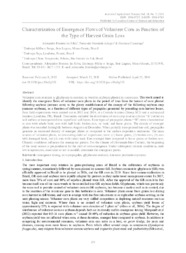Characterization of emergence flows of volunteer corn as function of the type of harvest grain loss.
Characterization of emergence flows of volunteer corn as function of the type of harvest grain loss.
Author(s): SILVA, A. F. da; ADEGAS, F. S.; CONCENCO, G.
Summary: Volunteer corn resistant to glyphosate is constant as weed in soybeans planted in succession. This work aimed to identify the emergence flows of volunteer corn plants in the period of time from the harvest of corn planted following soybean (autumn corn) to the plenty establishment of the canopy of the following soybean crop (summer soybean), as a function of different types of propagules generated by preceding corn harvest losses. Four field experiments were carried out in 2013 and 2014, at a Cerrado location (Sinop, MT) and a subtropical location (Londrina, PR), Brazil. Treatments included the distribution of corn crop residues (factor ?A?) either on soil surface or incorporated into superficial soil layers. Four types of propagules (factor ?B?) were characterized as ears with whole husk; ears with half husk; broken ears, no husk; and loose grains. The density of emerged plants was recorded fortnightly between August and December. When partially incorporated into soil, propagules generate an increased density of emerged plants as compared to the surface deposition treatments. The main sources of volunteer plants, in descending order of importance, were: (1) loose grains, (2) broken ears, (3) ears with damaged husk, and (4) ears with intact husk. Ears emerged later compared to loose grains or broken ears. Climatic conditions influence the emergence pattern. For the climate of (Savannah-like) Cerrado, the beginning of the rainy season is preponderant for the start of corn emergence. Under subtropical climatic conditions, mild low temperatures, associated or not to rainfall, determine the emergence peaks.
Publication year: 2018
Types of publication: Journal article
Unit: Embrapa Maize & Sorghum
Observation
Some of Embrapa's publications are published as ePub files. To read them, use or download one of the following free software options to your computer or mobile device. Android: Google Play Books; IOS: iBooks; Windows and Linux: Calibre.
Access other publications
Access the Agricultural Research Database (BDPA) to consult Embrapa's full library collection and records.
Visit Embrapa Bookstore to purchase books and other publications sold by Embrapa.

